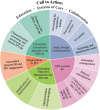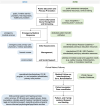Intimate Partner Violence-Related Brain Injury: Unmasking and Addressing the Gaps
- PMID: 38323539
- PMCID: PMC11564844
- DOI: 10.1089/neu.2023.0543
Intimate Partner Violence-Related Brain Injury: Unmasking and Addressing the Gaps
Abstract
Intimate partner violence (IPV) is a significant, global public health concern. Women, individuals with historically underrepresented identities, and disabilities are at high risk for IPV and tend to experience severe injuries. There has been growing concern about the risk of exposure to IPV-related head trauma, resulting in IPV-related brain injury (IPV-BI), and its health consequences. Past work suggests that a significant proportion of women exposed to IPV experience IPV-BI, likely representing a distinct phenotype compared with BI of other etiologies. An IPV-BI often co-occurs with psychological trauma and mental health complaints, leading to unique issues related to identifying, prognosticating, and managing IPV-BI outcomes. The goal of this review is to identify important gaps in research and clinical practice in IPV-BI and suggest potential solutions to address them. We summarize IPV research in five key priority areas: (1) unique considerations for IPV-BI study design; (2) understanding non-fatal strangulation as a form of BI; (3) identifying objective biomarkers of IPV-BI; (4) consideration of the chronicity, cumulative and late effects of IPV-BI; and (5) BI as a risk factor for IPV engagement. Our review concludes with a call to action to help investigators develop ecologically valid research studies addressing the identified clinical-research knowledge gaps and strategies to improve care in individuals exposed to IPV-BI. By reducing the current gaps and answering these calls to action, we will approach IPV-BI in a trauma-informed manner, ultimately improving outcomes and quality of life for those impacted by IPV-BI.
Keywords: biomarkers; brain injury; chronicity; intimate partner violence; late effects; neuroimaging; non-fatal strangulation.
Figures


References
-
- Breiding MJ, Chen J, Black MC. Intimate Partner Violence in the United States — 2010. Centers for Disease Control and Prevention: Atlanta, GA; 2014. Available from: https://www.cdc.gov/violenceprevention/pdf/cdc_nisvs_ipv_report_2013_v17... [Last accessed: January, 21, 2024]
-
- World Health Organization. Violence against women. 2021. Available from: https://www.who.int/news-room/fact-sheets/detail/violence-against-women [Last accessed: January 21, 2024]
-
- World Health Organization. Violence against women prevalence estimates, 2018: global, regional and national prevalence estimates for intimate partner violence against women and global and regional prevalence estimates for non-partner sexual violence against women. Geneva; 2021
Publication types
MeSH terms
Grants and funding
LinkOut - more resources
Full Text Sources
Medical
Miscellaneous

